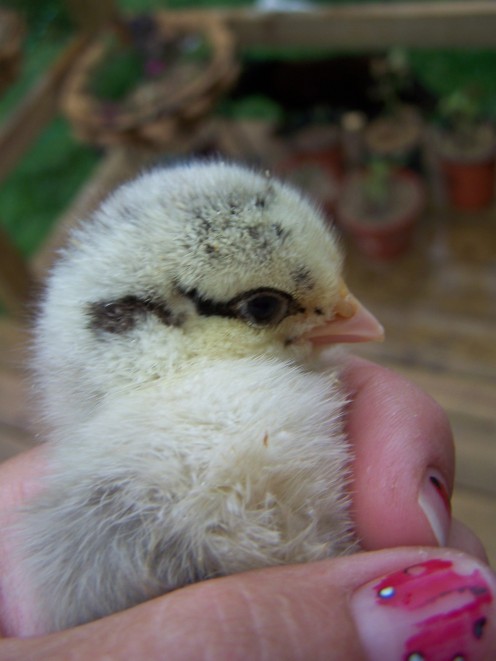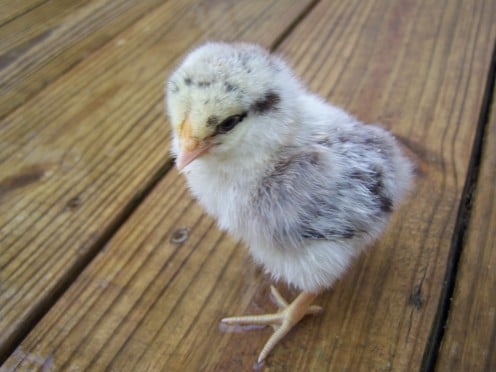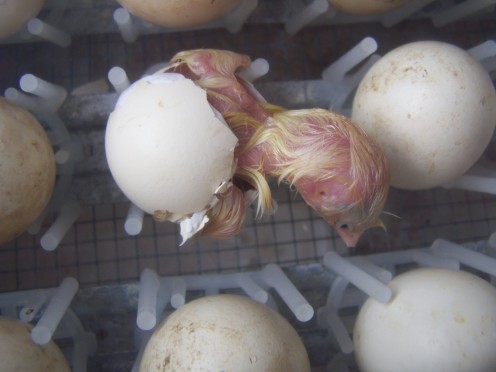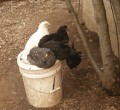How to raise day old chicks chickens

Raising day old and young chicks is an easy process! Keep reading to see how you can raise day old chicks and young chickens.


ALWAYS make sure your light and other electrical items are secured. They will burn your house down if they fall to the ground. Be safe and tie them up securely, away from anything flammable.
Warmth, water, food. The basic necessities of most babies. If you have these things, raising your day old chicks is easy!
Before you place your order for chicks (or before you hatch them out), have these items ready.
When at all possible, allow your hatched chicks to dry and fluff out in the incubator. Remove them if they start trying to eat your newly hatching chicks. Chicks are good at killing each other so keep your eyes peeled. Just place the chicks under the brooder light so they can finish fluffing out. Make sure they can move away from the light at first.
During the drying off process, do not add water to the brooder. The floppy chicks could drown in it. They don't have to drink in their first twenty four hours, or so. If you have to add water, try adding it on a platform only the more nimble chicks can climb up.
A room for the brooder and incubator. A room that doesn't get a lot of traffic is good. Make sure it has plenty of electrical outlets and the floor is easy to clean.
If it is carpeted, try laying down a large piece of linoleum, cardboard, plastic, or old cloths. When your chicks are just starting to flutter about, they will eventually escape and poo all over everything. Chickens are evil poop monsters!
A brooding light or other source of warmth. You can use the red bulb type or a regular light bulb. You only need to keep the chicks warm while they are so young. Try to aim for the brooder being at 97-98 degrees F. in its warmest part. Use a thermometer to keep a check on the temps.
I always set my brooders up so one part is that warm and then the rest of the box is cooler. This allow the chicks to move around and avoid overheating.
When I need to expand the brooder, I simply cut a hole in the bottom side of two boxes. I then place the holes together and the chicks can move freely between the two. I like to use those Rubbermaid type large totes for this. They are easy to disinfect and can be used for a long, long time!
Bedding. I use whatever I can find that won't harm the chicks. Usually this is recycled computer paper. I simply remove the paper and compost it as it gets dirty.
Chick starter. Buy a fifty pound sack of this but do not use the medicated variety if your chicks were immunized. It will screw the immunizations up. I also feed them dandelion seeds, roots, chickweed and a variety of other safe and nutritious greens and bugs. Provide a small amount of grit when adding variety to their diet. I use a sprinkle of clean sand across the floor so they don't fill up on sand.
Just add more sand when they gobble it all up. I usually add more every two days, or so.
I also moisten their chick starter with raw goat milk from my own goats.
A shallow watering dish. If your dish is deep, your chicks may drown. I use a few peanutbutter lids while the chicks are young. You have to keep refilling this or it will dry up quickly and the chicks can die.
You may be able to use chicken nipple watering devices. Just make sure the chicks are able to make them work.
Sugar water. For the first three or four days mix about a tablespoon of sugar in a 20 oz soda bottle of water. This is especially helpful with shipped day old chicks. I also add about a tablespoon of vinegar to 20 ounces of water. You can offer this in a separate dish.
When to put chicks outside. When your chicks have lots of good feathering, usually after a few weeks, they are ready for the yard. If you want to ensure they can stay warm, set the brooder light up in their coop. Eventually they won't even bother to use it.
Expect most chickens to start laying between six months to a year old. Some of the heritage breeds take longer than the production chickens. If you got your chickens from a hatchery like Murray McMurray Hatchery or Mount Healthy Hatchery, they will lay sooner than those from a heritage breeder. Heritage breeds tend to lay longer because they are not bred to lay as quickly as hatchery stock.
∞
I am sure I have forgotten something. I always seem to leave a little information out when I write. If you have any questions, just send me a message! We have been raising various forms of livestock for the better part of our lives and have learned a few tricks of the trade.
Raising chickens is easy. There are a million ways to do it and at times you might run into the jerks of the chicken world. They will rag on you for having hatchery stock or for using techniques not like their own. Just ignore those people. These are the people that think their chickens poop golden pellets.
Do what keeps your chickens healthy and to poo with the rest of the nay-Sayers!








